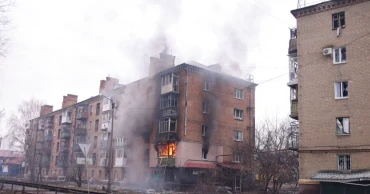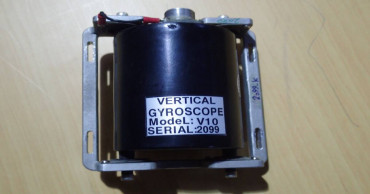drones
Seoul says North Korea prepares to destroy the northern sides of inter-Korean roads no longer in use
South Korea said Monday it has detected signs that North Korea is preparing to destroy the northern parts of inter-Korean roads no longer in use, as the rivals are embroiled in soaring tensions over North Korea’s claim that South Korea flew drones over its territory.
South Korea’s military said Monday it has found North Korea is engaging in works to prepare for the explosions. It’s not clear how much parts of the roads North Korea would destroy.
The development comes as North Korea has accused South Korea of launching drones to drop propaganda leaflets over Pyongyang three times this month and threatened to respond with force if it happened again.
In a statement Sunday, the North’s Defense Ministry said that the military had issued a preliminary operation order to artillery and other army units near the border with South Korea to “get fully ready to open fire.” The spokesperson said that the entire South Korean territory “might turn into piles of ashes” following the North’s powerful attack.
South Korea has refused to confirm whether it sent drones but warned it would sternly punish North Korea if the safety of its citizens is threatened.
Last week, North Korea said it will permanently block its border with South Korea and build front-line defense structures to cope with “confrontational hysteria” by South Korean and U.S. forces.
Read: North Korea vows to block border with South Korea, to build front-line defense structures
Tensions on the Korean Peninsula are at their highest point in years, with North Korea continuing a run of provocative weapons tests and South Korea and the U.S. expanding their military drills. KCNA said North Korea on Tuesday tested a long-range artillery system that observers say pose a direct threat to Seoul, the South Korean capital, which is only an hour’s drive from the border.
1 year ago
Israeli offensive in hard-hit northern Gaza kills and wounds dozens and threatens hospitals
A large-scale Israeli operation in northern Gaza has killed and wounded dozens of people and threatens to shut down three hospitals over a year into the war with Hamas, Palestinian officials and residents said Wednesday.
Heavy fighting is underway in Jabaliya, where Israeli forces carried out several major operations over the course of the war and then returned as militants regroup. The entire north, including Gaza City, has suffered heavy destruction and has been largely isolated by Israeli forces since late last year.
The continuing cycle of destruction and death in Gaza, unleashed by Hamas' Oct. 7, 2023, attack on southern Israel, comes as Israel expands a week-old ground offensive against Hezbollah in Lebanon and considers a major retaliatory strike on Iran.
Residents of Jabaliya, a refugee camp dating back to the 1948 war surrounding Israel's creation, say heavy airstrikes and evacuation warnings have driven hundreds of people from their homes. An airstrike early Wednesday killed at least nine people, including two women and two children, according to the Al-Ahly Hospital, which received the bodies.
Strikes in central Gaza killed another nine people, including three children, according to the Al-Aqsa Martyrs Hospital in Deir al-Balah. An Associated Press reporter counted the bodies.
The Gaza Health Ministry said Wednesday that the overall Palestinian death toll in Gaza since the start of the war has surpassed 42,000, with more than 97,000 others wounded.
Palestinians huddle inside as fighting rages
Residents of Jabaliya said thousands of people have been trapped in their homes since the operation began Sunday, as Israeli jets and drones buzz overhead and troops battle militants in the streets.
“It’s like hell. We can’t get out,” said Mohamed Awda, who lives in Jabaliya with his parents and six siblings. He said there were three bodies in the street outside his home that could not be retrieved because of the fighting.
“The quadcopters are everywhere, and they fire at anyone. You can’t even open the window,” he told The Associated Press by phone, speaking over the sound of explosions.
Read: Hezbollah steps up rocket fire as Israel sends more troops into Lebanon
He and other residents fear Israel’s aim is to depopulate the north and turn it into a closed military zone or a Jewish settlement. Israel has blocked all roads except for the main highway leading from Jabaliya to the south, according to residents.
“We are concerned about the displacement to the south,” Ahmed Qamar, who lives in Jabaliya with his wife, children and parents, said in a text message. "People here say clearly that they will die here in northern Gaza and and won’t go to southern Gaza.”
Hospitals are under threat
Fadel Naeem, director of the Al-Ahly Hospital in Gaza City, said it has received dozens of dead and wounded people from across the northern half of the Palestinian enclave since Israel launched its air and ground operation.
Israel's offensive has gutted Gaza's health sector, forcing most of its hospitals to shut down and leaving the rest only partially functioning.
“The situation is tense,” Naeem told The Associated Press in text message. “We declared a state of emergency, suspended scheduled surgeries, and discharged patients whose conditions are stable.”
He said three hospitals further north — Kamal Adwan, Awda and the Indonesian Hospital - have become almost inaccessible because of the fighting. The Gaza Health Ministry says the Israeli army has ordered all three to evacuate staff and patients. Meanwhile, no humanitarian aid has entered the north since Oct. 1, according to U.N. data.
The Israeli military did not immediately respond to requests for comment on the hospitals or the apparent suspension of aid delivery in the north.
Read more: Marcon calls for halt on arms deliveries to Israel for use in Gaza
Rear Adm. Daniel Hagari, the military spokesperson, said late Tuesday that Israeli forces were operating in Jabaliya “to prevent Hamas' regrouping efforts" and had killed around 100 militants, without providing evidence. Israel says it only targets militants and blames civilian deaths on Hamas because it fights in residential areas.
Israel ordered the wholesale evacuation of northern Gaza, including Gaza City, in the opening weeks of the war, but hundreds of thousands of people are believed to have remained there. Israel reiterated those instructions over the weekend, telling people to flee south to an expanded humanitarian zone where hundreds of thousands are already crammed into squalid tent camps.
The war began just over a year ago, when Hamas-led militants stormed into southern Israel, killing some 1,200 people, mostly civilians, and abducting around 250. They are still holding around 100 hostages, a third of whom are believed to be dead.
Israel's offensive has killed 42,010 Palestinians, according to the Gaza Health Ministry, which does not say how many were fighters. It has said women and children make up over half of the dead. The offensive has also caused staggering destruction across the territory and displaced around 90% of the population of 2.3 million people, often multiple times.
Israel warns Lebanon that it could end up like Gaza
Israeli Prime Minister Benjamin Netanyahu has vowed to keep fighting until “total victory” over Hamas and the return of all the captives.
On Tuesday, he warned that Lebanon would meet a similar fate if its people did not rise up against Hezbollah, which began firing rockets into Israel after the initial Hamas attack. That set in motion a cycle of escalation that ignited a full-scale war last month.
“You have an opportunity to save Lebanon before it falls into the abyss of a long war that will lead to destruction and suffering like we see in Gaza,” Netanyahu said, addressing the Lebanese people.
In recent weeks Israel has waged a punishing air campaign across large parts of Lebanon, targeting what it says are Hezbollah rocket launchers and other militant sites. In a matter of days, strikes killed Hezbollah leader Hassan Nasrallah and most of his top commanders.
Read more:Israel intensifies bombardment of Gaza and southern Lebanon ahead of Oct. 7 anniversary
So far, ground operations appear to be focused on a narrow strip along the border, but Israel has warned people to evacuate dozens of cities and towns across southern Lebanon, many of them north of a buffer zone declared by the United Nations after the last war between Israel and Hezbollah in 2006.
Hezbollah's acting leader, Sheikh Naim Kassem, said in a televised statement Tuesday that the group has replaced its slain commanders and was preventing Israeli ground forces from advancing. The militants have extended their rocket fire deeper into Israel, disrupting life but causing few casualties.
Israel is meanwhile considering options for a strike on Iran that could potentially escalate the war on yet another front. Iran, which supports Hezbollah and Hamas, launched a wave of some 180 ballistic missiles at Israel last week in retaliation for the killing of top militants from both groups.
1 year ago
Drones target 6 regions in biggest attack on Russia since troops sent to Ukraine, officials say
Russian officials accused Ukraine of targeting six Russian regions with drones early Wednesday in what appears to be the biggest drone attack on Russian soil since Moscow sent troops into Ukraine 18 months ago.
Drones hit an airport in the western Pskov region and started a massive fire there, the governor and local media reported. More drones were shot down over Oryol, Bryansk, Ryazan, Kaluga and the Moscow region surrounding the Russian capital, according to the Defense Ministry.
The strike in Pskov hit an airport in the region's namesake capital and damaged four Il-76 transport aircraft, Russia’s state news agency Tass reported, citing emergency officials.
Pskov regional Gov. Mikhail Vedernikov ordered all flights to and from the airport canceled Wednesday so damage could be assessed during daylight.
Russia says it has confirmed Prigozhin died in the plane crash
Footage and images posted on social media showed smoke billowing over the city of Pskov and a large blaze. Vedernikov said there were no casualties, and the fire has been contained. Unconfirmed media reports said between 10 and 20 drones could have attacked the airport.
Pskov was the only region where officials reported damage. Three drones were shot down over the Bryansk region, according to the Russian military, and two over the Oryol region, its Gov. Andrei Klychkov said. Two were downed over the Ryazan region, one more over Kaluga, and one more over the Moscow region, officials said.
Kremlin denies role in plane crash believed to have killed Russian mercenary leader Prigozhin
No damage or casualties were registered in those regions, although some Russian media cited residents of the Bryansk region as saying that they heard a loud explosion.
UN Security Council, minus China and Russia, condemns Myanmar military's killing of civilians
Also on early Wednesday, Russian-installed officials in the annexed Crimea reported repelling an attack of drones targeting the harbor of the port city of Sevastopol. Moscow-appointed governor of Sevastopol Mikhail Razvozzhayev said it wasn't immediately clear how many of the drones have been destroyed. It wasn't immediately clear if the attack caused any damage.
2 years ago
Russia says drones damage Moscow buildings in pre-dawn attack, blames Ukraine
Russian air defenses stopped eight drones converging on Moscow, officials said Tuesday, in an attack that authorities blamed on Ukraine, while Russia pursued its relentless bombardment of Kyiv with a third assault on the city in 24 hours.
The Russian defense ministry said five drones were shot down and the systems of three others were jammed, causing them to veer off course. It called the incident a "terrorist attack" by the "Kyiv regime."
The attack caused "insignificant damage" to several buildings, Moscow Mayor Sergei Sobyanin said. Two people received medical attention for unspecified injuries but did not need hospitalization, he said in a Telegram post. Residents of two high-rise buildings damaged in the attack were evacuated, Sobyanin said.
Andrei Vorobyov, governor of the wider Moscow region, said some of the drones were "shot down on the approach to Moscow."
Ukraine made no immediate comment on the attack, which would be one of its deepest and most daring strikes into Russia since the Kremlin launched its full-scale invasion of Ukraine more than 15 months ago.
The attacks have raised questions about the effectiveness of Russia's air defense systems.
A senior Russian lawmaker, Andrei Kartapolov, told Russian business news site RBC that "we have a very big country and there will always be a loophole where the drone can fly around the areas where air defense systems are located."
Kartapolov said the purpose of the attacks was to unnerve the Russian people. "It's an intimidation act aimed at the civilian population," RBC quoted him as saying. "It's designed to create a wave of panic."
Moscow residents reported hearing explosions before dawn. Police were seen working at one site of a crashed drone in southwest Moscow. An area near a residential building was fenced off, and police put the drone debris in a cardboard box before carrying it away.
At another site, apartment windows were shattered and there were scorch marks on the building's front.
It was the second reported attack on Moscow. Russian authorities said two drones targeted the Kremlin earlier this month in what they portrayed as an attempt on President Vladimir Putin's life.
Ukrainian drones have reportedly flown deep into Russia several times. In December, Russia claimed it had shot down drones at airfields in the Saratov and Ryazan regions. Three soldiers were reported killed in the attack in Saratov, which targeted an important military airfield.
Earlier, Russia reported shooting down a Ukrainian drone that targeted the headquarters of its Black Sea Fleet in Sevastopol in Russia-annexed Crimea.
In Ukraine, Russia launched a pre-dawn air raid on Kyiv, killing at least one person and sending the capital's residents again scrambling into shelters.
At least 20 Shahed explosive drones were destroyed by air defense forces in Kyiv's airspace in Russia's third attack on the capital in the past 24 hours, according to early information from the Kyiv Military Administration. Overall, Ukraine shot down 29 of 31 drones fired into the country, most in the Kyiv area, the air force later added.
Before daylight, the buzzing of drones could be heard over the city, followed by loud explosions as they were taken down by air defense systems.
In the overnight attacks on Kyiv, one person died and seven were injured, according to the municipal military administration. A high-rise building in the Holosiiv district caught fire after being hit by debris either from from drones being hit or interceptor missiles.
The building's upper two floors were destroyed, and there may be people under the rubble, the Kyiv Military Administration said. More than 20 people were evacuated.
Resident Valeriya Oreshko told The Associated Press in the aftermath that even though the immediate threat was over, the attacks had everyone on edge.
"You are happy that you are alive, but think about what will happen next," the 39-year-old said.
A resident who gave only her first name, Oksana, said the whole building shook when it was hit.
"Go to shelters, because you really do not know where it (the drone) will fly," she advised others. "We hold on."
Elsewhere in the capital, falling debris caused a fire in a private house in Darnytskyi district and three cars were set alight in Pechersky district, according to the military administration.
The series of attacks that began Sunday included a rare daylight attack Monday that left puffs of white smoke in the blue skies.
On that day, Russian forces fired 11 ballistic and cruise missiles at Kyiv at about 11:30 a.m., according to Ukraine's chief of staff, Valerii Zaluzhnyi. All of them were shot down, he said.
Debris from intercepted missiles fell in Kyiv's central and northern districts during the morning, landing in the middle of traffic on a city road and also starting a fire on the roof of a building, the Kyiv military administration said. At least one civilian was reported hurt.
The Russian Defense Ministry said it launched a series of strikes early Monday targeting Ukrainian air bases with precision long-range air-launched missiles. It claimed the strikes destroyed command posts, radars, aircraft and ammunition stockpiles, but didn't say anything about hitting cities or other civilian areas.
2 years ago
Russia launches ‘exceptional’ air attack in Kyiv with drones, missiles
Loud explosions sounded above Kyiv early Tuesday as Russia launched an intense air attack on the capital using a combination of missiles launched from the air, sea and land.
Russia's latest attack on Kyiv was “exceptional in its density — the maximum number of attacking missiles in the shortest period of time,” said Serhii Popko, the head of the Kyiv military administration.
It is the eighth time this month that Russian air raids have targeted the capital, a clear escalation after weeks of lull and ahead of a much-anticipated Ukrainian counter-offensive. It also comes as President Volodymyr Zelenksyy concludes a whirlwind European tour to greet Ukraine's key wartime allies, which spurred an additional tranche of pledged military aid.
Also Read: Zelenskyy's European tour aimed to replenish Ukraine's arsenal and build political support
“According to preliminary information the vast majority of enemy targets in the airspace of Kyiv were detected and destroyed,” said Popko.
Ukraine's Air Force said 18 missiles of various types were launched, including drones, cruise missiles and ballistic missiles. All were intercepted and shot down, said Air Force spokesman Yurii Ihnat.
Six “Kinzhal” aero-ballistic missiles were launched from MiG-31K aircraft, nine cruise missiles from ships in the Black Sea and three land-based S-400 cruise missiles targeted the capital, said Ihnat in a statement on Telegram.
After the first onslaught, Russia also launched Iranian-made Shahed attack drones and conducted aerial reconnaissance, Ihnat said.
Debris fell across several districts in the capital. In the Solomyansky district, causing a fire in a non-residential building. The fire was extinguished.
Debris set cars on fire and fell on the grounds of a zoo, but no losses were reported, said Kyiv Mayor Vitali Klitschko.
2 years ago
Drones fly deep inside Russia; Putin orders border tightened
Drones that the Kremlin said were launched by Ukraine flew deep inside Russian territory, including one that got within 100 kilometers (60 miles) of Moscow, signaling breaches in Russian defenses as President Vladimir Putin ordered stepped-up protection at the border.
Officials said the drones caused no injuries and did not inflict any significant damage, but the attacks on Monday night and Tuesday morning raised questions about Russian defense capabilities more than a year after the country's full-scale invasion of its neighbor.
Ukrainian officials did not immediately take responsibility, but they similarly have avoided directly acknowledging responsibility for past strikes and sabotage while emphasizing Ukraine’s right to hit any target in Russia.
Although Putin did not refer to any specific attacks in a speech in the Russian capital, his comments came hours after the drones targeted several areas in southern and western Russia. Authorities closed the airspace over St. Petersburg in response to what some reports said was a drone.
Also Tuesday, several Russian television stations aired a missile attack warning that officials blamed on a hacking attack.
Also Read: Flurry of drone strikes hits Russia as TV, radio are hacked
The drone attacks targeted regions inside Russia along the border with Ukraine and deeper into the country, according to local Russian authorities.
A drone fell near the village of Gubastovo, less than 100 kilometers (60 miles) from Moscow, Andrei Vorobyov, governor of the region surrounding the Russian capital, said in an online statement.
The drone did not cause any damage, Vorobyov said, but it likely targeted “a civilian infrastructure object.”
Pictures of the drone showed it was a small Ukrainian-made model with a reported range of up to 800 kilometers (nearly 500 miles) but no capacity to carry a large load of explosives.
Russian forces early Tuesday shot down another Ukrainian drone over the Bryansk region, local Gov. Aleksandr Bogomaz said in a Telegram post.
Three drones also targeted Russia’s Belgorod region on Monday night, with one flying through an apartment window in the capital, local authorities reported. Regional Gov. Vyacheslav Gladkov said the drones caused minor damage to buildings and cars.
The Russian Defense Ministry said Ukraine used drones to attack facilities in the Krasnodar region and neighboring Adygea. It said the drones were brought down by electronic warfare assets, adding that one of them crashed into a field and another diverted from its flight path and missed a facility it was supposed to attack.
Russia's state RIA Novosti news agency reported a fire at the oil facility, and some other Russian reports said that two drones exploded nearby.
While Ukrainian drone strikes on the Russian border regions of Bryansk and Belgorod have become a regular occurrence, other strikes reflected a more ambitious effort.
Some Russian commentators described the drone attacks as an attempt by Ukraine to showcase its capability to strike deep behind the lines, foment tensions in Russia and rally the Ukrainian public. Some Russian war bloggers described the raids as a possible rehearsal for a bigger, more ambitious attack.
Andrei Medvedev, a commentator with Russian state television who serves as a deputy speaker of Moscow’s city legislature and runs a popular blog about the war, warned that the drone strikes could be a precursor to wider attacks within Russia that could accompany Ukraine’s attempt to launch a counteroffensive.
“The strikes of exploding drones on targets behind our lines will be part of that offensive,” Medvedev said, adding that Ukraine could try to extend the range of its drones.
Russia hawks urged strong retaliation. Igor Korotchenko, a retired Russian army colonel turned military commentator, called for a punishing strike on the Ukrainian presidential office in Kyiv.
Another retired military officer, Viktor Alksnis, noted that the drone attacks marked the expansion of the conflict and criticized Putin for failing to deliver a strong response.
Also on Tuesday, authorities reported that airspace around St. Petersburg, Russia's second-largest city, was temporarily closed, halting all departures and arrivals at the main airport, Pulkovo. Officials did not give a reason for the move, but some Russian reports claimed that it was triggered by an unidentified drone.
The Russian Defense Ministry said it was conducting air defense drills in western Russia.
Last year, Russian authorities repeatedly reported shooting down Ukrainian drones over annexed Crimea. In December, the Russian military said Ukraine used drones to hit two bases for long-range bombers deep inside Russian territory.
Speaking at Russia’s main security agency, the FSB, Putin urged the service to tighten security on the Ukraine border.
In another development that fueled tensions across Russia on Tuesday, an air raid alarm interrupted the programming of several TV channels and radio stations in several regions. Russia’s Emergency Ministry said in an online statement that the announcement was a hoax “resulting from a hacking of the servers of radio stations and TV channels in some regions of the country."
Meanwhile, satellite photos analyzed by The Associated Press appeared to show a Russian warplane in Belarus that Belarusian guerrillas claimed to have targeted as largely intact.
Tuesday’s high-resolution images from Planet Labs PBC and Maxar Technologies showed the Russian A-50 early warning and control aircraft after what Belarusian opposition activists described as an attack on the Machulishchy air base Sunday outside the Belarusian capital of Minsk.
However, a discoloration could be seen on the aircraft's distinctive, circular rotodome above its fuselage that could be damage. That discoloration wasn't seen in earlier images of the aircraft at the air base. The Maxar image also showed what appeared to be vehicles near the airplane as well.
Belarusian activists supporting Ukraine alleged that the aircraft was seriously damaged. Russian and Belarusian officials did not comment on the claims.
In Ukraine, four people were killed and five others wounded Tuesday by renewed Russian shelling of the southern Ukrainian city of Kherson, regional Gov. Oleksandr Prokudin said in a Telegram.
A 68-year-old man was also killed as Russian forces shelled Kupiansk, a town in Ukraine’s northeastern Kharkiv region, Gov. Oleh Syniehubov said.
The fiercest fighting continued to be in eastern areas of Ukraine, where Russia wants control over all four of the provinces it illegally annexed in September.
Ukrainian officials said Russian forces have deployed additional troops and equipment, including the latest T-90 battle tanks, in those areas.
In a video address, Ukraine's President Volodymyr Zelenskyy thanked U.S. industrialists for supporting Ukraine and voiced hope for their support in rebuilding the country after the war. Zelenskyy noted that the country faces a “colossal task” to restore hundreds of thousands of damaged sites, including “whole cities, industries, productions."
2 years ago
S. Korea military sorry for failing to down North’s drones
South Korea’s president on Tuesday called for stronger air defenses and high-tech stealth drones while the military apologized for failing to shoot down North Korean drones that crossed the border for the first time in five years.
South Korea’s military scrambled warplanes and attack helicopters on Monday, but they failed to bring down any of the North Korean drones that flew back home or disappeared from South Korean radars. It raised serious questions about South Korea’s air defense network at a time when tensions remain high over North Korea’s torrid run of missile tests this year.
On Tuesday, the military again launched fighter jets and attack helicopters after spotting suspicious flight paths at a front-line area. A local county office sent emergency text messages notifying residents of a new batch of North Korean drones. But the military later said it was a flock of birds.
“We have a plan to create a military drone unit tasked with monitoring key military facilities in North Korea. But we’ll advance the establishment of the drone unit as soon as possible because of yesterday’s incident,” President Yoon Suk Yeol said during a regular Cabinet Council meeting. “We’ll also introduce state-of-the art stealth drones and bolster our surveillance capability.”
He said that South Korea’s military needs more intensive readiness and exercises to cope with threats posed by North Korean drones.
Lt. Gen. Kang Shin Chul, chief director of operation at the Joint Chiefs of Staff, said in a televised statement the military feels sorry because of its failure to shoot down the North Korean drones and for causing big public concerns.
Kang acknowledged South Korea lacks capacities to detect and strike small surveillance drones with a wingspan of less than 3 meters (9.8 feet) though it has assets to spot and bring down bigger combat drones. Kang said South Korea will establish drone units with various capacities and aggressively deploy military assets to shoot down enemy drones.
It was the first time North Korean drones entered South Korean airspace since 2017. The drone flights came three days after South Korea said North Korea launched two short-range ballistic missiles, extending its record testing activities this year.
North Korea has touted its drone program, and South Korean officials have previously said the North had about 300 drones. Advanced drones are among modern weapons systems that North Korean leader Kim Jong Un has vowed to procure, along with multi-warheads, underwater-launched nuclear missiles and a spy satellite.
Read more: S. Korea’s leader calls for stealth drones to monitor North
Since taking office in May, Yoon, a conservative, has expanded regular military drills with the United States and vowed to sternly deal with North Korean provocations. He’s offered massive support plans to North Korea if it abandons its nuclear weapons, but the North has rejected his overture.
On Monday, South Korea sent its own surveillance assets, apparently unmanned drones, across the border as corresponding steps against the North Korean drone flights. South Korea’s public confirmation of reconnaissance activities inside North Korea is highly unusual and likely reflects a resolve by Yoon’s government to get tough on North Korean provocations.
Yoon used the drone incident to hit at his liberal predecessor’s engagement policy with North Korea. He said Tuesday South Korea’s military had conducted little anti-drone training since 2017, when Moon Jae-in was inaugurated.
“I think our people must have seen well how dangerous a policy relying on the North’s good faiths and (peace) agreements would be,” he said.
Moon’s liberal opposition Democratic Party accused Yoon of shifting his government’s “security disaster” to someone else. Party spokesperson Park Sung-joon called on Yoon to thoroughly disclose what he did when the North Korean drones were flying in South Korean territory.
Moon was credited with arranging now-dormant diplomacy on North Korea’s nuclear program, but also faced criticism that his appeasement policy allowed North Korea to buy time and boost its nuclear arsenal despite international sanctions. During his campaigning, Yoon described Moon’s government as “subservient” to North Korea and accused him of undermining South Korea’s seven-decade military alliance with the United States.
Read more: Kim claims N. Korean successes, wants to overcome challenges
Earlier Tuesday, North Korea’s state media announced the start of a key ruling Workers’ Party meeting the previous day to review past policies and discuss next year’s plans.
During the meeting, Kim Jong Un called for stronger efforts to overcome hardships and challenges facing his country. But he still claimed North Korea has reported some successes “in the arduous course” and said his country’s national strength has “remarkably” increased in military, economic and other areas, according to the Korean Central News Agency.
Some observers say Kim may need such propaganda-driven claims to draw greater public loyalty to bolster his weapons arsenal and address economic woes while facing U.S.-led sanctions and pressure campaigns to curb his nuclear ambitions.
The North Korean Workers’ Party meeting is expected to last several days, and Kim will likely address issues such as his arms buildup, relations with the United States and the economy in later sessions.
3 years ago
Drones start Covid vaccines delivery in Northeast, make first drop in Manipur
Union Health Minister Mansukh Mandaviya on Monday launched an initiative to facilitate COVID-19 vaccine delivery to tough and hard-to-reach terrains of the Northeast through drones.
According to The Print, the ICMR’s Drone Response and Outreach in North East (i-Drone), a delivery model to make sure that life-saving COVID vaccines reach everyone, is in line with the government’s commitment to Antyodaya’ in health – making healthcare accessible to the last citizen of the country, officials said.
This is for the first time that a “Make in India’ drone has been used in South Asia to transport COVID-19 vaccine over an aerial distance of 15 km in 12-15 mins from the Bishnupur district hospital to Loktak lake, Karang island in Manipur for administration at the PHC.
Read:India's Everest Twins Tashi and Nungshi Malik Summit the Swiss Alps- Make India proud yet again
“The actual road distance between these locations is 26 km. Today, 10 beneficiaries will receive the first dose and eight will receive the second dose at the PHC,” Mandaviya said.
Thanking Prime Minister Narendra Modi, the Union Health Minister said, Under his leadership, the nation is progressing at a great pace. Today is a historic day, which showed us how technology is making life easier and bringing social change.
India is home to geographical diversities and drones can be used to deliver essentials to the last mile, he said.
“We can use drones in delivering important life-saving medicines, collecting blood samples. This technology can also be used in critical situations. This technology may prove a game-changer in addressing the challenges in health care delivery, particularly health supplies in difficult areas,” Mandaviya said.
Launching the initiative which would facilitate vaccine delivery to hard-to-reach terrains of India, the Union Health Minister said, Our immunisation programme for COVID-19 has already exceeded all expectations.
Read:Eye on China, India looks to step up engagement with Indian Ocean
“I strongly believe that this initiative will further help us achieve the highest possible immunisation coverage for COVID-19. Incorporating such drone technologies into the national programmes would help deliver other vaccines and medical supplies as quickly as possible.
Despite the effective and safe vaccine administration in the states and Union Territories, the vaccine delivery in tough and hard-to-reach terrains of India is still challenging.
The i-Drone has been designed to overcome these challenges by deploying Unmanned Aerial vehicles (UAV) / drones to remote areas, the health ministry said.
Currently, the drone-based delivery project has been granted permission for implementation in Manipur and Nagaland, as well as the Union Territory of Andaman and Nicobar Islands.
The ICMR conducted an initial study in collaboration with the Indian Institute of Technology, Kanpur to test the capacity of drones to carry and transfer vaccines safely.
Read:Farmers' protests brew into a political crisis in India's largest state
The study was conducted in Manipur, Nagaland and Andaman and Nicobar. These studies provided promising results on the basis of which the Ministry of Civil Aviation (MoCA), Directorate General of Civil Aviation (DGCA) and other regulatory authorities have granted permission to fly drones beyond the Visual Line Of Sight.
Mandaviya expressed confidence in the initiative and noted that it can be helpful in delivering not only vaccines but also other medical supplies. This will help in overcoming the gaps in current vaccine delivery mechanisms, he said
He thanked the Ministry of Civil Aviation, DGCA and the Airport Authority of India for their support towards this endeavour and congratulated ICMR, health workers and all associated with this landmark initiative.
4 years ago
Coronavirus: CMP using drones to ensure social distancing
Chattogram Metropolitan Police (CMP) is using drones to ensure that people maintain social distancing and do not come out of their homes without emergency works.
Though police are raising awareness about maintaining social distance, people are hardly paying any attention. People continue to gather at alleys ignoring the government directive aimed at preventing the spread of coronavirus.
Whenever police approach, they run away and again come out when the law enforcers leave. CMP sources said they will use the drones to take photos and videos of people violating government directive and take action against them.
5 years ago
Devices found in missiles, Yemen drones link Iran to attacks
A small instrument inside the drones that targeted the heart of Saudi Arabia's oil industry and those in the arsenal of Yemen's Houthi rebels match components recovered in downed Iranian drones in Afghanistan and Iraq, two reports say.
5 years ago







.jpg)








